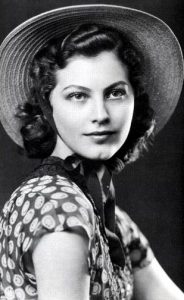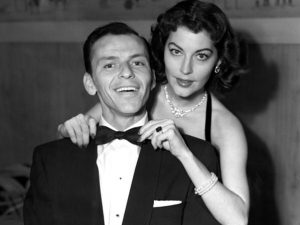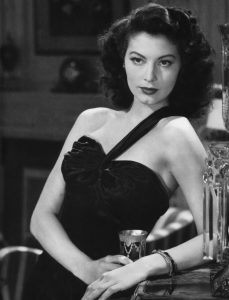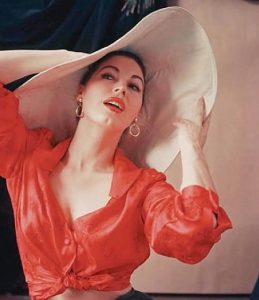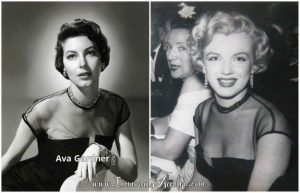
Ava’s Life and Career
Ava Lavinia Gardner was born on Christmas Eve, 1922, youngest of seven children. Her father was a sharecropper in Grabtown, North Carolina. “Ours was a neighbourly and self-sufficient society,” Ava recalled. A tomboy who loved to run barefoot, her early memories were idyllic. But the economic ravages of the 1930s eventually forced the Gardners to move away.
Her father died soon after, and the family made ends meet by opening a boarding house. “I hated their eyes as they looked at me,” Ava said of their male lodgers. “They never touched me, but they tried to flirt, and even though I was only thirteen years old, I instinctively knew what was going on.”
Her destiny changed forever during a trip to New York, visiting her eldest sister, Beatrice, who was dating photographer Larry Tarr. His portrait of a fresh-faced Ava, hair tied in a bonnet, led to a screen test and, eventually, a contract with MGM.
Not long after her arrival, Ava was wooed by MGM’s hottest young star, Mickey Rooney. They married in 1942, but divorced a year later. In 1945, she married bandleader Artie Shaw. It was to be another short-lived romance, as Shaw constantly criticised Ava for what he saw as her intellectual failings. She was also courted for many years by the eccentric businessman, Howard Hughes, but refused to marry him.
Ava’s early years at MGM were uneventful, as she was largely eclipsed by the studio’s reigning pin-up, Lana Turner. Her name appeared on a marquee for the first time when she starred in the now-forgotten Ghosts on the Loose. Her big break came in 1946, when she played the vampish Kitty Collins in Robert Siodmak’s classic film noir, The Killers. It was based on a short story by Ernest Hemingway, and her co-star was newcomer Burt Lancaster.
From the outset, Ava rebelled against MGM’s strict regime. She was a party girl who liked to play the field. In the paranoid, ‘red-baiting’ atmosphere of post-war Hollywood, Ava was too outspoken for her own good. Despite her willful exterior, Ava lacked confidence in her talent. She felt unsupported by MGM, who seemed more interested in promoting her physical attributes. When the veteran stage actor, Charles Laughton, coached her on the set of The Bribe (1949), she remarked, “He was the only one in all my film years who took the time and went out of his way to try and make an actress out of me.”
“Some women fall for writers, some for sailors, some for fighters,” Ava once wrote. “I’ve always loved musicians.” In 1949, Frank Sinatra’s career was in a slump. When the news of his adulterous affair with Ava broke in 1950, the couple were condemned by Hedda Hopper, Louella Parsons and the Catholic Legion of Decency.
They married a year later, and even after their 1957 divorce, remained close for the rest of their lives. “Our love was deep and true,” Ava explained, “even though the fact that we couldn’t live with each other any more than we couldn’t live without each other sometimes made it hard to understand.”
After their separation in 1955, Ava moved to Spain. “If I hadn’t cared for Hollywood in its heyday,” she remarked, “it certainly had less attractions for me now that things seemed to be falling apart.” With her MGM contract at an end, she was a free agent. She starred with Gregory Peck in the apocalyptic drama, On The Beach (1959), and struck up a friendship with Ernest Hemingway, having appeared in two more adaptations of his work; The Snows of Kilimanjaro (1952) and The Sun Also Rises (1957).
While living in Spain, Ava also befriended Robert Graves. He wrote several poems in her honour, which delighted her more than any Hollywood trophy. In 1964, starred in the first of three films made with John Huston, The Night of the Iguana. Two years later, she played Sarah, wife of Abraham, in The Bible: In the Beginning.
By 1968, Ava had moved to London. Her later roles included a cameo as actress Lily Langtry in Huston’s The Life and Times of Judge Roy Bean (1972), and a disaster movie, Earthquake (1973.) She continued working in television until 1986.
On January 25, 1990, Ava Gardner died of pneumonia. She was 67, and had been suffering from emphysema and an auto-immune disease (possibly Lupus.) Her body was flown from England to North Carolina, where she was buried alongside her parents and siblings.
Marilyn Connections
As cinematic icons, they are light and dark – different sides of the same spectrum. “I know a lot of men fantasize about me; that’s how Hollywood gossip becomes Hollywood history,” Ava told journalist Peter Evans.
“Someday someone is going to say, ‘All the lies ever told about Ava Gardner,’ and the truth about me, just like poor, maligned Marilyn, will disappear like names on old tombstones. I know I’m not defending a spotless reputation. Hell, it’s too late for that. Scratching one name off my dance card won’t mean a row of beans in the final tally. It’s just that I like to keep the books straight while I’m still around and sufficiently sober and compos mentis to do it.”
Marilyn and Ava had a lot of commonalities in their lives. Both grew up and poverty. Norma Jeane’s life, like Ava’s, was transformed by a photograph, taken by David Conover while she was working at a munitions plant in 1945.
Both starlets would serve a long apprenticeship, posing for endless ‘cheesecake’ shots while waiting for their big break. Marilyn savoured her own marquee moment when she starred in a low-budget musical, Ladies of the Chorus (1948.)
In 1947, Marilyn fell in love with musician Fred Karger. But he mocked her lack of education, just as Artie Shaw had while married to Ava. Both women would study for a time at UCLA, and Ava later discovered that her IQ was considerably higher than her ex-husband might have thought. Marilyn was a gifted artist, singer, and a voracious reader all her life, and she also wrote poetry and fragments of prose. Writers like Norman Rosten, Truman Capote, Carson McCullers and Carl Sandburg were among her friends.
In 1950, she played a bit part in The Fireball, starring Mickey Rooney. He later claimed they had an affair, his stories growing with each telling. “Reenie, he’s still the biggest liar in the world,” Ava would tell her maid. “Poor Mickey, he cannot tell the truth, he never could. But he’s cute.”
Ava would be Mankiewicz’s first choice for the lead in his 1954 film, The Barefoot Contessa. “Getting along with Joe Mankiewicz was problematical at times,” she recalled. Nonetheless, she had a powerful ally in cameraman Jack Cardiff, who had previously photographed her in the whimsical English fantasy, Pandora and the Flying Dutchman (1951.) Cardiff would subsequently work his magic on Marilyn in The Prince and the Showgirl (1957.)
Hailed as ‘the new Jean Harlow’, Marilyn signed a seven-year contract with Twentieth Century-Fox in 1951. She worked with Charles Laughton in O. Henry’s Full House – Ava had previously also found a supporter in Laughton early in her career. A year later she won the lead in Niagara, as a ‘femme fatale’ not unlike Ava in The Killers.
Ava and Marilyn grew up during the golden age of Hollywood, when movies offered an escape from hard times. In later life, they would both star alongside one of the greatest stars of that era, Clark Gable. Ava appeared with him in The Hucksters (1947), Lone Star (1953), and Mogambo (1953), a remake of Gable’s 1932 hit, Red Dust. Mogambo earned Ava an Oscar nomination.
Her most demanding film was Bhowani Junction (1956), and she credited her strong performance to George Cukor’s direction. Famed as a ‘woman’s director’, Cukor made two films with Marilyn: Let’s Make Love (1960), and the unfinished Something’s Got to Give.
Though briefly considered for Ava’s role in The Sun Also Rises, Marilyn was turned off by Ernest Hemingway’s macho persona. “People tell me he loves shooting animals and killing fish,” she said to W.J. Weatherby. “I think a writer – an artist – should set an example. He shouldn’t add to all the killing in the world. He should add to the love.”
After her marriage to Miller ended, Marilyn was briefly involved with Ava’s ex-husband, Frank Sinatra. Her final years were dogged by severe depression and addiction to sleeping pills. When a new play by Arthur Miller, After the Fall, opened on Broadway in 1964 (just two years after Marilyn died), many were outraged by its depiction of a troubled star, seemingly based on his ex-wife – including novelist James Baldwin, who asked Ava to join him in picketing the theatre.
Like many other stars, Ava was photographed in a dress Marilyn also wore on multiple occasions.
At first glance, Ava seemed more self-assured than Marilyn ever was. But she too had known poverty, and suffered from nagging self-doubt. Both were lauded for their beauty, but their talents were undervalued. Each tried to escape – Marilyn through drugs, and Ava with alcohol.
-Tara Hanks for Immortal Marilyn


